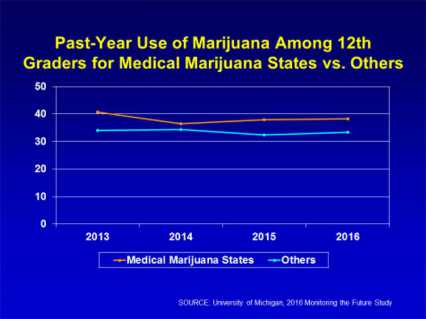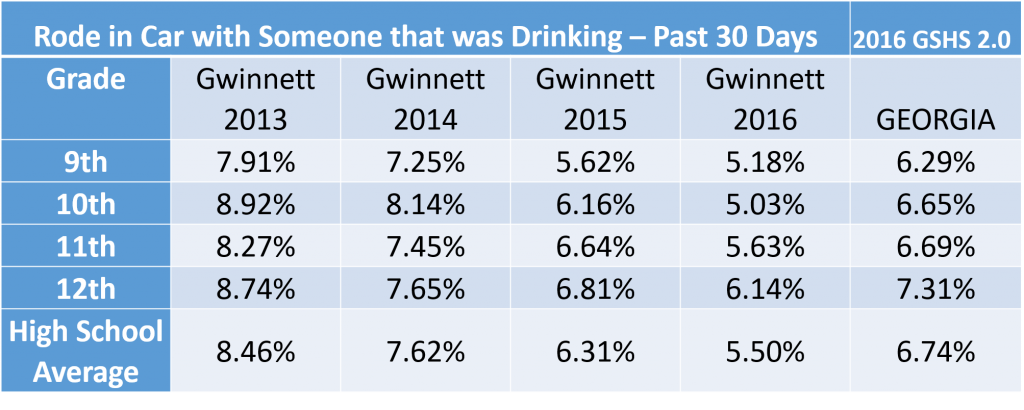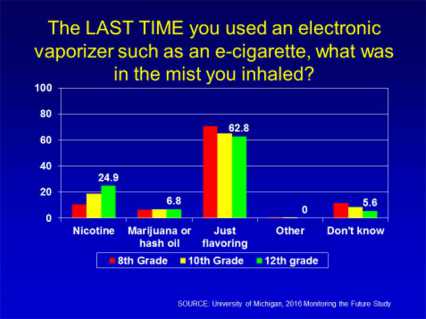Nationally, the 2016 Monitoring the Future survey shows a steady “decline in the use of many illicit substances” among teens, such as alcohol, marijuana, tobacco and prescription drug misuse.
The report shows that the percentage of teens reporting that they have “been drunk” in the last year is the lowest ever seen from this survey, and the percentage of 12th graders reporting being drunk at least once went down from 53.2% in 2001 to 37.3% in 2016.
Marijuana use has also dropped significantly, specifically among eighth graders. It continues to be relatively stable among seniors, but usage is much higher than those of eight graders. Marijuana usage is also higher for 12th graders in states with medical marijuana laws than states that don’t have them. “For example, in 2016, 38.3 percent of high school seniors in states with medical marijuana laws reported past year marijuana use, compared to 33.3 percent in non-medical marijuana states, reflecting previous research that has suggested that these differences precede enactment of medical marijuana laws.”

It is also important to note that the survey reveals marijuana and e-cigarettes are more appealing than regular tobacco cigarettes. Not only did the use of e-cigarettes surpass the use of regular cigarettes, in all three grades surveyed, there was a significant drop in the use of tobacco cigarettes, and there seems to be a long-term decline of cigarette smoking that has been developing over the past 25 years. This is a clear result of our nation’s “success of widespread public health anti-smoking campaigns and policy changes.”
We are also seeing this decline in Georgia and even more so in Gwinnett County. According to the Georgia Student Health Survey 2.0, just between 2015 and 2016, the percentage of 12th graders in Gwinnett County that reported having at least one drink of alcohol in the past 30 days dropped from 18.24% to 15.66%. In Georgia, the percentage is at 19.18% for 12th graders. The numerous strategies that focused on reducing retail and social availability of underage alcohol in Gwinnett County and the numerous collaborations assisted greatly in having a lower than the statewide average.

When it comes to exposure to risk (driving while drinking or riding with someone who is drinking), we are also seeing a decline in Gwinnett from the 2016 Georgia Student Health Survey 2.0.


All these numbers show how well the community prevention efforts are working. Strategies such as compliance checks, positive social norms campaigns, new policies and ordinances and enforcement of current laws all assist in creating the community level change.
The bad news is that we, as a community, tend to become more complacent when the news is good. Some may think that declining numbers means we fixed the problem, and it’s time to move on to the next issue facing our community. That’s not the case. When it comes to substance use and abuse, it’s imperative to continue the efforts to assure that usage does not go up. Marketing of alcohol and smoking/vaping products continue relentlessly, making the products appealing to our youth. New flavors are developed, such as glazed donut, bubble gum or S’mores vodka, which tempt more youth to try the drink. Apple fritter, bubble gum, caramel candy and butterscotch flavor concentrates are all marketed as e-flavors that one can order on-line without any problem, which is why we can’t just stop preventative measures.
One question in the 2016 Monitoring the Future survey asked students what was in the mist that they inhaled from an electronic vaporizer. The results were astonishing. In the chart below, you will notice how high the “just flavoring” response is, especially for 8th grade. From what one reads about the cartridges, there is no standard and/or an agency that checks and assures quality of whatever is being put into them. So, this group is getting used to the smoking, and they truly don’t know what all is in the flavoring and/or the cartridge they buy.

In the words of Michael Botticelli, National Drug Control Policy Director, “We must continue to do all we can to support young people through evidence-based prevention efforts as well as treatment for those who may develop substance use disorders.” Let’s not let the latest good news slow down the community focus on all the prevention strategies. Our youth need us!
